The Kingdom of Morocco


This golden-stoned adobe kasbah (fortress) thrusts dramatically out of the earth amid scenery that wows all who visit. It’s a fairy-tale place, and unsurprisingly the orange-hued turrets and curvy lanes inside have become a favorite film location for Hollywood due to the surreal beauty of the place.
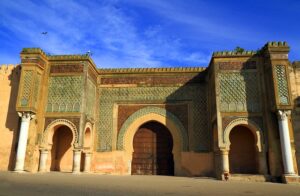
This mammoth gateway (which guards the entrance to Meknes’ Imperial City district from the medina) is noted for its stunning decoration. Meant as a monumental reminder of the sultan’s might, the Bab al-Mansour is a magnificent relic of Meknes’ glorious era as capital of Morocco. It’s widely regarded as Morocco’s grandest and best preserved gateway.
According to Britannica, Although the country is rapidly modernizing and enjoys a rising standard of living, it retains much of its ancient architecture and even more of its traditional customs. Morocco’s largest city and major Atlantic Ocean port is Casablanca, an industrial and commercial centre. The capital, Rabat, lies a short distance to the north on the Atlantic coast. Other port cities include Tangier, on the Strait of Gibraltar, Agadir, on the Atlantic, and Al-Hoceïma, on the Mediterranean Sea.
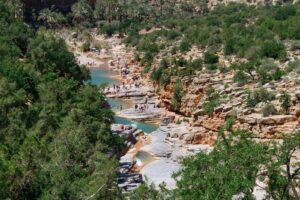
The city of Fès is said to have some of the finest souks, or open-air markets, in all of North Africa. Scenic and fertile, Morocco well merits the praise of a native son, the medieval traveler Ibn Baṭṭūṭah, who wrote that “it is the best of countries, for in it fruits are plentiful, and running water and nourishing food are never exhausted.”

Set amidst the Rif Mountains, Chefchaouen – also known as the blue city is a small town in a huge landscape.
This small town in the Rif mountains if famed for its quaint blue-painted houses, which give it a decidedly surreal look and feel
Country ProfileOfficial Name:
Al Mamlakah al-Maghribiyah
short form: Arabic: المغرب, al-Maġrib
int’l long form: Kingdom of Morocco
int’l short form: Morocco
ISO Country Code: ma
Country Calling Code: +212
Capital City: Rabat
Other Cities: Agadir, Casablanca, Fez, Marrakech, Meknes, Tangier (Tanger), Tetouan
Type: Constitutional Monarchy.
Independence: 2 March 1956 (from France).Geography:
Location: Northern Africa, bordering the North Atlantic Ocean and the Mediterranean Sea.
Area: 446,550 km² (172,413 sq. mi.)
(The disputed territory of Western Sahara comprises another 267,000 km² or 102,700 sq. mi.).
Terrain: Coastal plains, mountains, desert.
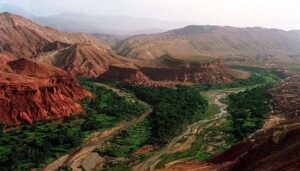
One of the best places in Morocco for those who seek paths less taken, Rose Valley is as beautiful as it can get. With various hues of green, pristine blue waters, snow-capped Atlas Mountains, and vast patches of olive and fig trees forming its landscape.
Climate: Mediterranean, more extreme in the interior.
People:
Nationality: Moroccan(s).
Population: 36.3 million (in 2021)
GNI per capita PPP: $ 4 444 (year)
Ethnic groups: Arab, Berber, mixed Arab-Berber.
Religions: Muslim
Languages: Arabic (official), several Berber dialects; French, usually the language of business, government, and diplomacy.
Literacy: 52%
Natural resources: Phosphates, iron ore, manganese, lead, zinc, fish, salt.

The city’s stunning moresque buildings, which meld the French-colonial design with the traditional Moroccan style, is the best thing to admire here. Owing to its awesome food and architecture, it is definitely among the best places to travel in Morocco.
Agriculture products: Barley, wheat, citrus, wine, vegetables, olives; livestock.
Industries: Phosphate rock mining and processing, food processing, leather goods, textiles, construction, tourism.
Currency: Moroccan Dirham (MAD)
Exports – commodities: clothing and textiles, automobiles, electric components, inorganic chemicals, transistors, crude minerals, fertilizers (including phosphates), petroleum products, citrus fruits, olives, dates, vegetables, and fish.
Exports – partners: Spain 23%, France 19% (2019)
Imports – commodities: crude petroleum, textile fabric, telecommunications equipment, wheat, gas and electricity, transistors, plastics.
Imports – partners: Spain 19%, France 11%, China 9%, United States 7%, Germany 5%, Turkey 5%, Italy 5% (2019)

Tucked between the High Atlas Mountains and the gorgeous Sahara Desert, Tinghir is Morocco’s crown jewel that sits snugly in the center of the Todra Valley and is probably one of the best places to see in Morocco for couples. Unlike other places in this country, Tinghir happens to be an old French town which has now turned into a sprawling city entertaining tourists with splendid flower gardens, Kasbahs, and rustic narrow streets.
Morocco borders Algeria to the east and southeast, Western Sahara to the south, the Atlantic Ocean to the west, and the Mediterranean Sea to the north. It is the only African country with coastal exposure to both the Atlantic Ocean and the Mediterranean Sea. Its area—excluding the territory of Western Sahara, which Morocco controls—is slightly larger than the U.S. state of California. Two small Spanish enclaves, Ceuta and Melilla, are situated on the country’s northern coast.
Morocco claims ownership of the non-self-governing territory of Western Sahara, which it has designated its Southern Provinces. In 1975, after Spain agreed to decolonise the territory and cede its control to Morocco and Mauritania, a guerrilla war broke out between those powers and some of the local inhabitants. In 1979, Mauritania relinquished its claim to the area, but the war continued to rage. In 1991, a ceasefire agreement was reached, but the issue of sovereignty remained unresolved. Today, Morocco occupies two-thirds of the territory, and efforts to resolve the dispute have thus far failed to break the political deadlock.
Morocco is officially divided into 12 regions,which, in turn, are subdivided into 62 provinces and 13 prefectures.
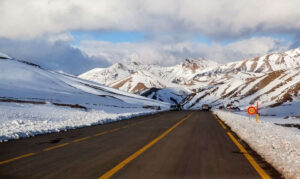
High-Atlas
Being North Africa’s highest mountain range, High Atlas is popularly known as the mountain of mountains. This place is a paradise for trekkers, especially from spring to autumn. It runs diagonally across Morocco for approximately 1000 km, and its saw-toothed Jurassic peaks act as a weather barrier.
Regions
- Tanger-Tetouan-Al Hoceima
- Oriental
- Fès-Meknès
- Rabat-Salé-Kénitra
- Béni Mellal-Khénifra
- Casablanca-Settat
- Marrakech-Safi
- Drâa-Tafilalet
- Souss-Massa
- Guelmim-Oued Noun
- Laâyoune-Sakia El Hamra
- Dakhla-Oued Ed-Dahab(Wikipedia
CULTURE
Morocco is a country with a rich culture and civilisation. Through Moroccan history, it has hosted many people coming from East (Phoenicians, Jews and Arabs), South (Sub-Saharan Africans) and North (Romans, Andalusians). All those civilisations have affected the social structure of Morocco.
According to Wikipedia, Since independence, a veritable blossoming has taken place in painting and sculpture, popular music, amateur theatre, and filmmaking. The Moroccan National Theatre (founded 1956) offers regular productions of Moroccan and French dramatic works. Art and music festivals take place throughout the country during the summer months, among them the World Sacred Music Festival at Fès.
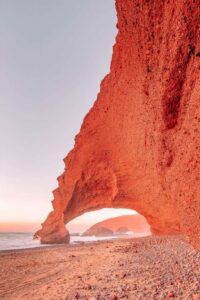
Sidi Ifni
The most fascinating thing about this fishing town in the southwest of Morocco is its Spanish heritage. Interestingly, Sidi Ifni was originally a Spanish territory, and traces of this are still visible today.
Each region possesses its own specificities, thus contributing to the national culture and to the legacy of civilization. Morocco has set among its top priorities the protection of its diverse legacy and the preservation of its cultural heritage.
Culturally speaking, Morocco has always been successful in combining its Berber, Jewish and Arabic cultural heritage with external influences such as the French and the Spanish and, during the last decades, the Anglo-American lifestyles.
Cuisine
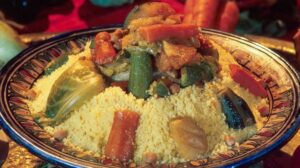
Moroccan Couscous With Meat and Seven Vegetables
Moroccan cuisine is considered one of the most diversified cuisines in the world. This is a result of the centuries-long interaction of Morocco with the outside world.
The cuisine of Morocco is mainly a fusion of Moorish, European and Mediterranean cuisines.
Spices are used extensively in Moroccan cuisine. While spices have been imported to Morocco for thousands of years, many ingredients such as saffron from Tiliouine, mint and olives from Meknes, and oranges and lemons from Fez, are home-grown. Chicken is the most widely eaten meat in Morocco. The most commonly eaten red meat in Morocco is beef; lamb is preferred but is relatively expensive. The main Moroccan dish most people are familiar with is couscous, the old national delicacy.

Snail soup is a Moroccan dish you can find all over the country. Use a toothpick to pick out the snails from the shells then slurp up to the soup. Locals believe the broth is good for digestion and fever.
Image: pinterest
According to Wikipidia, Beef is the most commonly eaten red meat in Morocco, usually eaten in a Tagine with vegetables or legumes. Chicken is also very commonly used in Tagines, knowing that one of the most famous tagine is the Tagine of Chicken, potatoes and olives. Lamb is also consumed, but as Northwest African sheep breeds store most of their fat in their tails, Moroccan lamb does not have the pungent flavour that Western lamb and mutton have. Poultry is also very common, and the use of seafood is increasing in Moroccan food. In addition, there are dried salted meats and salted preserved meats such as kliia/khlia and “g’did” which are used to flavor tagines or used in “el ghraif” a folded savory Moroccan pancake.
Among the most famous Moroccan dishes are Couscous, Pastilla (also spelled Bsteeya or Bestilla), Tajine, Tanjia and Harira. Although the latter is a soup, it is considered a dish in itself and is served as such or with dates especially during the month of Ramadan. Pork consumption is forbidden in accordance with Sharia, religious laws of Islam.

Chermoula is a mix of herbs and spices used when grilling or baking fish and seafood. Depending on the mix, you’ll get flavors of onion, coriander, chili peppers, or saffron. Often times you’ll see it as a dipping sauce too
A big part of the daily meal is bread. Bread in Morocco is principally from durum wheat semolina known as khobz. Bakeries are very common throughout Morocco and fresh bread is a staple in every city, town and village. The most common is whole grain coarse ground or white flour bread. There are also a number of flat breads and pulled unleavened pan-fried breads.
The most popular drink is “atai”, green tea with mint leaves and other ingredients. Tea occupies a very important place in the culture of Morocco and is considered an art form. It is served not only at mealtimes but all through the day, and it is especially a drink of hospitality, commonly served whenever there are guests. It is served to guests, and it is impolite to refuse it.
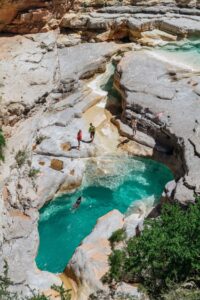
Sources: Wikipedia, Britannica, Nationonline,
https://handluggageonly.co.uk/2017/06/30/10-beautiful-places-visit-morocco/,
https://www.planetware.com/tourist-attractions/morocco-mar.htm,
https://www.google.com/amp/s/traveltriangle.com/blog/best-places-to-visit-in-morocco/amp/,
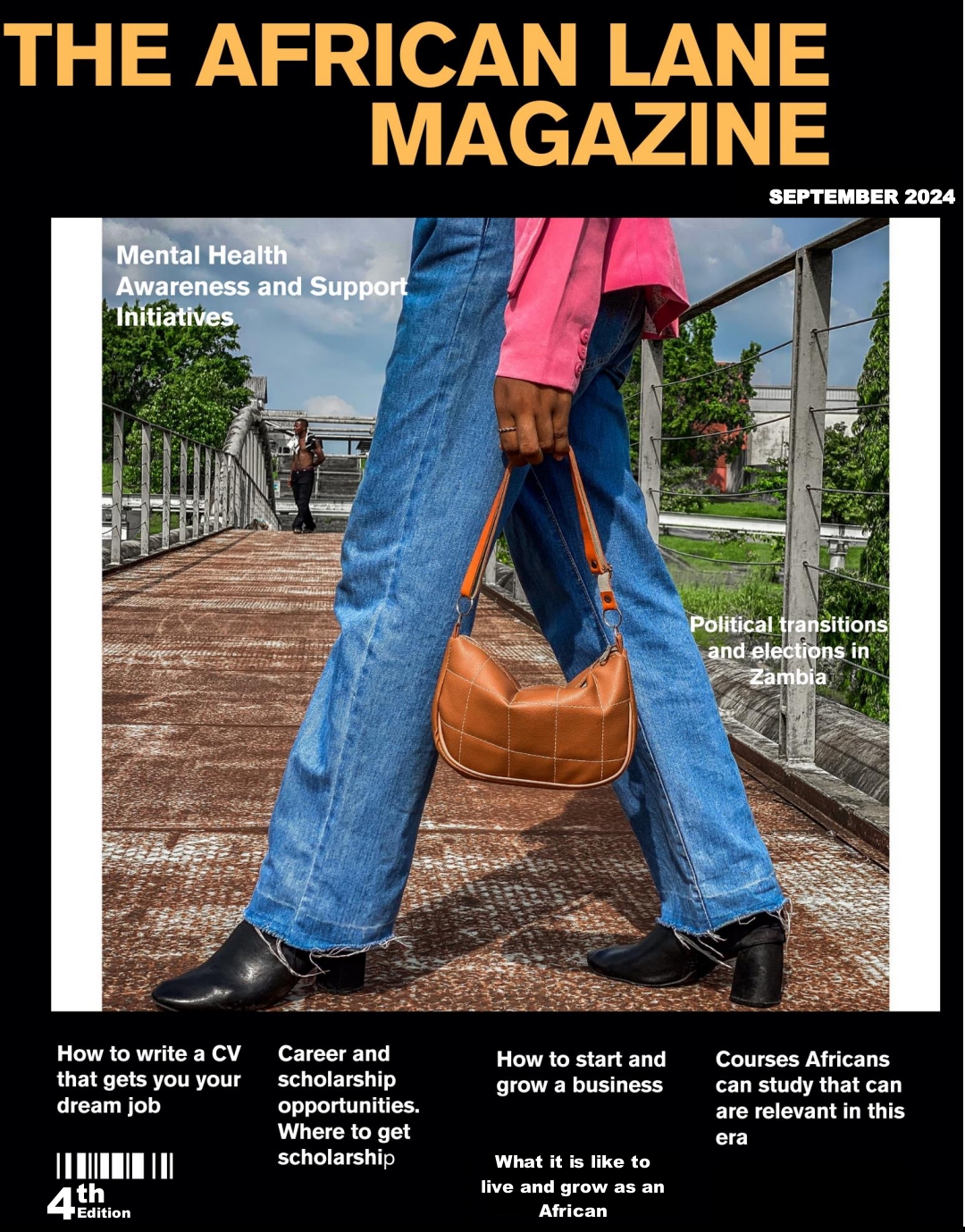
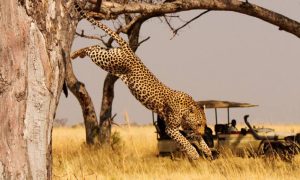
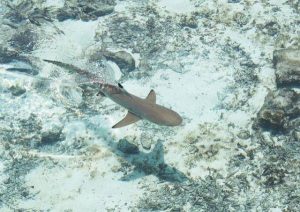
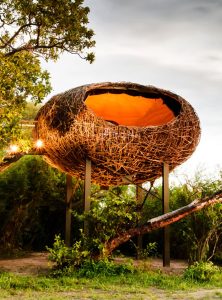
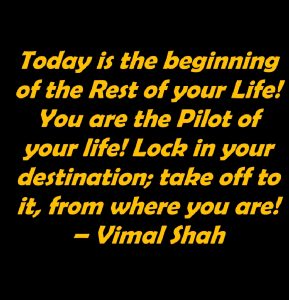
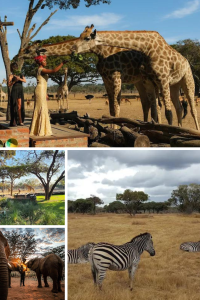
Thanks for your marvelous posting! I genuinely enjoyed reading it, you might be a great author.I will remember to bookmark your blog and definitely will come back later on. I want to encourage you continue your great work, have a nice day!